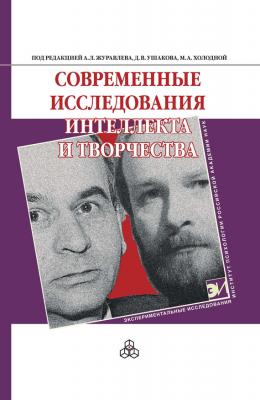Современные исследования интеллекта и творчества. Коллектив авторов
Читать онлайн.| Название | Современные исследования интеллекта и творчества |
|---|---|
| Автор произведения | Коллектив авторов |
| Жанр | Общая психология |
| Серия | Экспериментальные исследования |
| Издательство | Общая психология |
| Год выпуска | 2015 |
| isbn | 978-5-9270-0301-3 |
Таким образом, точка в понимании инсайта еще не поставлена, дискуссия продолжается.
Литература
Вертгеймер М. Продуктивное мышление. М., 1987. Оригинальная работа: Wertheimer M. Productive thinking. N. Y.: Harper & Brothers. 1945.
Дункер К. Качественное (экспериментальное и теоретическое) исследование продуктивного мышления // Психология мышления. М., 1965. С. 21–85. Оригинальная работа: Duncker K. A qualitative (experimental and theoretical) study of productive thinking (solving of comprehensible problems) // Journal of Genetic Psychology. 1926. V. 33. Р. 642–708.
Келер В. Исследование интеллекта человекоподобных обезьян. М.: Комакадемия, 1930.
Кун Т. Структура научных революций. М., 1975.
Bourne L., Ekstrand B., Dominowski R. L. The psychology of thinking. N. J.: Prentice-Hall, 1971.
Dominowski R. L. Comment on “An examination of the alleged role of ‘Fixation’ in the solution of several ‘Insight’ problems” by Weisberg & Alba// Journal of Experimental Psychology: General. 1981. V. 110. P. 199–203.
Durkin H. E. Trial and error, gradual analysis and sudden reorganization: an experimental study of problem solving // Archive of Psychology. 1937., V. 30. № 210. P. 1–85.
Durso F. T., Rea C. B., Dayton T. Graph-theoretic confirmation of restructuring during insight // Psychological Science. 1994. V. 5. № 2. P. 94–98.
Ellen P. Direction, past experience, and hints in creative problem solving: Reply to Weisberg & Alba // Journal of Experimental Psychology: General. 1982. V. 111. № 3. P. 316–325.
Fleck J. I., Weisberg R. W. The use of verbal protocols as data: an analysis of insight in the candle problem // Memory & Cognition. 2004. V. 32. № 6. P. 990–1006.
Glass A. L., Holyoak K. J., Santa J. L. Cognition. Reading, Mass.: Addison-Wesley, 1979.
Hebb D. O. Organization of behavior. N. Y.: John Wiley & Son., 1949.
Jausovec N., Bakracevic K. What can heart rate tell us about creative process? // Creativity Research Journal. 1995. V. 8. № 1. P. 11–24.
Kaplan C., Simon H. А. In search of insight // Cognitive Psychology. 1990. V. 22. P. 374–419.
Knoblich G., Ohlsson S. Constraint relaxation and chunk decomposition in insight problem solving // Journal of Experimental Psychology: Learning, Memory and Cognition. 1999. V. 25. № 6. P. 1534–1555.
Knoblich G., Ohlsson S., Raney G. E. An eye movement study of insight problem solving // Memory & Cognition. 2001. V. 29. № 7. P. 1000–1009.
Köhler W. Intelligenzprufungen an Menschenaffen. Berlin, Springer-Verlag, 1917.
Luchins A. S., Luchins E. H. Rigidity of behavior: A variational approach to the effects of Einstellung. Eugene: University of Oregon Press, 1959.
MacGregor J. N., Ormerod T. C., Chronicle E. P. Information processing and insight: A process model of performance on the nine-dot and related problems // Journal of Experimental Psychology: Learning, Memory and Cognition. 2001. V. 27. № 1. P. 176–201.
Maier N. R. F. Reasoning in humans. I. On direction // Journal of Comparative Psychology. 1930. V. 10. P. 115–143.
Metcalfe J. Feeling of knowing in memory and problem solving // Journal of Experimental Psychology: Learning, Memory and Cognition, 1986a. V. 12. № 2. P. 288–294.
Metcalfe J. Premonitions of insight predict impending error // Journal of Experimental Psychology: Learning, Memory and Cognition. 1986b. V. 12. № 4. P. 623–634.
Metcalfe J., Wiebe D. Intuition in insight and noninsight problem solving // Memory & Cognition/ 1987. V. 15. № 3. P. 238–46.
Newell A., Simon H. A. Human problem solving. Englewood Cliffs, N. J.: Prentice-Hall, 1972.
Ohlsson S. Restructuring revisited: I. Summary and critique of the Gestalt theory of problem solving // Scandinavian Journal of Psychology. 1984a. V. 25. N 1. P. 65–78.
Ohlsson S. Restructuring revisited. II. An information processing theory of restructuring and insight // Scandinavian Journal of Psychology. 1984b. V. 25. № 1. P. 117–129.
Ohlsson S. Information-processing explanations of insight and related phenomena // Advances in the Psychology of Thinking / Keane M. T., Gilhooly K. J. (Eds). L: Harvester-Wheatsheaf. 1992. V. 1. P. 1–44.
Öllinger M., Jones G., Faber A., Knoblich G. Cognitive mechanisms of insight: the role of heuristics and representational change in solving the eight-coin problem // Journal of Experimental Psychology: Learning, Memory and Cognition. 2013. V. 39. № 3. P. 931–939.
Ormerod T. C., MacGregor J. N., Chronicle E. P. Dynamics and
